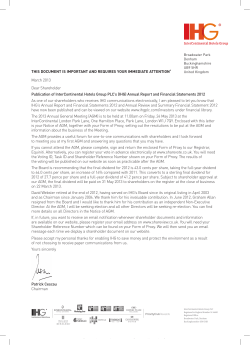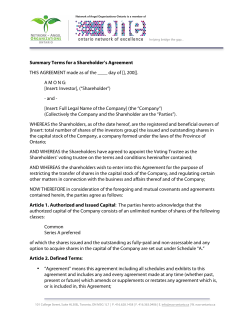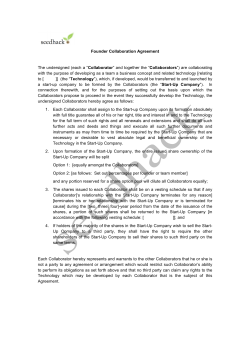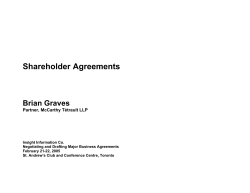
Buy/Sell Agreements - Promissory Note Method
1 Buy/Sell Agreements - Promissory Note Method Introduction This Tax Topic deals with the promissory note method of handling a buy/sell commitment to purchase the shares of a corporation upon the death of a shareholder. This method utilizes corporate-owned insurance to fund the buy/sell commitment. For a discussion of alternative methods for buy/sell agreements, refer to Tax Topics entitled, “Buy/Sell Agreements - An Overview of Funding with Life Insurance”, “Buy/Sell Agreements - Criss-Cross Purchase Method (with trustee)”, “Buy/Sell Agreements - Criss-Cross Purchase Method (without trustee)”, “Buy/Sell Agreements Corporate Redemption Method” and "Buy/Sell Agreements - Hybrid Method”. Fact Situation For purposes of discussion, the following facts will be assumed: 1. Mr. A and Mr. B are equal shareholders in Opco, a Canadian-controlled private corporation (“CCPC”), the shares of which qualify for the enhanced capital gain exemption; 2. The adjusted cost base (“ACB”) of each shareholder's shares is $100. The paid-up capital of these shares is also $100; 3. The shares in Opco have a fair market value of $1,000,000; and 4. A buy/sell agreement is in place between Mr. A and Mr. B which is fully funded with corporate-owned life insurance. In other words, Opco owns a policy on the life of each shareholder, each with a face amount of $500,000. For discussion purposes, we will assume that the ACB of each policy is nil. Structure of Buy/Sell Arrangement Under this type of arrangement, Mr. A would agree to purchase Mr. B's shares on Mr. B's death, and Mr. B's estate would be under a corresponding obligation to sell the shares to Mr. A. Mr. B would have a similar obligation to purchase Mr. A's shares on the latter's death. Opco would be the owner and beneficiary of the life insurance policies and would pay all premiums. For example, on the death of Mr. A the following transactions would take place: 1. Mr. B would purchase Mr. A's shares from his estate using a promissory note pursuant to the shareholders agreement; 2. Opco would then use the life insurance proceeds received on Mr. A's death to pay a dividend to Mr. B. Opco would elect to pay the dividend out of its capital dividend account (“CDA”) to the extent of the CDA balance; and 3. Mr. B would then use the dividend to retire the promissory note given on the purchase of Mr. A's shares. It should be noted that Mr. A's shares are purchased by Mr. B prior to Opco declaring the dividend. Otherwise, the estate of Mr. A would be entitled to a dividend on its shares. This in turn would mean that the surviving shareholder would not receive sufficient funds (in the form of a tax-free dividend) to retire the promissory note given on the purchase of the shares from the estate. 2 Income Tax Consequences The attached Appendix shows the detailed tax consequences of the above transactions. A summary of these tax consequences is as follows: Income Tax Consequences to Deceased Shareholder Upon his death, Mr. A will be deemed by subsection 70(5) of the Income Tax Act (the Act) to have disposed of his shares in Opco at proceeds equal to their fair market value of $500,000 immediately before death. The excess of the deemed proceeds of $500,000 over the ACB of the shares is a capital gain for tax purposes. Half of this amount would be reported in Mr. A's terminal tax return as a taxable capital gain. Mr. A may be able to use his capital gains exemption to offset all or part of this gain. For a more detailed discussion of the lifetime capital gains exemption refer to the Tax Topic entitled, “The Lifetime Capital Gains Exemption.” Income Tax Consequences to Deceased Shareholder’s Estate Mr. A's estate would acquire the Opco shares with an ACB of $500,000 (equal to the deemed proceeds to Mr. A on his death). When the estate sells the shares to Mr. B pursuant to the buy/sell agreement no gain or loss would be realized as the ACB is equal to the purchase price. Income Tax Consequences to the Surviving Shareholder Mr. B would purchase Mr. A's shares from the Estate at the amount specified in the agreement. The ACB of his original shares and the newly-acquired shares would be averaged for the purposes of determining any gain or loss upon the subsequent disposition of those shares. The amount of life insurance proceeds received by Opco, less the ACB of the insurance policy, would be credited to Opco's capital dividend account. In this example, we are assuming that the ACB of the policy is nil, thereby creating a $500,000 credit to the CDA. Assuming there are no other current or past transactions affecting the CDA, the corporation’s CDA balance will be $500,000. Therefore, the $500,000 of life insurance proceeds can be distributed to Mr. B as a tax-free capital dividend. Legal Considerations Shareholders agreements are always recommended in any share ownership arrangement. Buy-sell provisions within a shareholders agreement can contemplate the type of buy/sell structure selected. The agreement can address how the insurance is owned, how the premiums will be paid and who will be the beneficiary under the policies. There are a number of clauses that should generally be considered when life insurance is used for funding a buy-sell obligation. Refer to the guide entitled, “A guide to general insurance provisions for buy-sell on death and disability” for sample wording. In addition the following specific issues should be considered: a) Timing of dividend With the promissory note method, the corporation is the owner and beneficiary of the policy and this should be reflected in the agreement. One of the most common drafting errors with the promissory note method is the timing of the dividend. In some instances, an agreement may create a situation where a dividend is required to be declared and payable to the estate prior to the promissory note being received by the personal representative of the estate. Unless the estate and the survivor have separate classes of shares the declaration of a dividend would result in a pro-rata receipt by all shareholders of the same class. The surviving shareholders would then not have enough funds to retire the outstanding promissory note held by the estate of the deceased shareholder. 3 b) The capital dividend account It is important that the shareholders agreement does not require the declaration of a capital dividend equal to the death benefit proceeds from the life insurance policy or equal to the CDA credit arising from the receipt of the life insurance death benefit. A requirement of this type can result in an excessive CDA election which has significant punitive tax consequences. If the full death benefit from a life insurance policy is elected as a capital dividend, an excessive election could occur because a CDA credit is only available to the extent the proceeds exceed the ACB of the policy. An excessive election could also occur if the CDA balance was negative before the addition of the CDA credit arising from the life insurance death benefit. Refer to the “Capital Dividend Account” Tax Topic for a detailed description of the CDA calculation, and an example illustrating when it might be negative. c) Promissory note limitation period It is common, with loans among private corporations or family members, that no payments of principal or interest are made for many years. In these cases, it is prudent to consider whether the note may be unenforceable. All of the provinces have one or more limitations statutes that may cause a promissory note to become inadvertently unenforceable. It is important to understand when the limitation period begins to run under the applicable statute so that steps can be taken to ensure the note is properly drafted to deal with limitation issues and what steps, if any, must be taken to keep the liability under the note from expiring. For sample wording in relation to the use of the promissory note method to purchase shares funded with insurance see the clauses contained in Appendix “B”. Conclusions In general, the promissory note method may be favoured in situations where the capital gains realized by the deceased would be sheltered under the capital gains exemption and it is desirable to use corporate owned insurance to fund the buy/sell. This is because the deceased shareholder pays no tax on any gains realized on death in respect of his or her shares, and the surviving shareholder(s) are able to increase the cost basis of their shares by the amount paid to the deceased's estate. However, whenever the promissory note method is considered, it is usually advantageous to consider a hybrid form of buy/sell agreement, which combines elements of the promissory note method and the corporate redemption method. The hybrid method provides additional tax planning flexibility upon the death of a shareholder, and is discussed in detail in the Tax Topic entitled “Buy/Sell Agreements - Hybrid Method”. Last updated: November 2013 The Tax & Estate Planning Group at Manulife Financial writes various publications on an ongoing basis. This team of accountants, lawyers and insurance professionals provides specialized information about legal issues, accounting and life insurance and their link to complex tax and estate planning solutions. These publications are distributed on the understanding that Manulife Financial is not engaged in rendering legal, accounting or other professional advice. If legal or other expert assistance is required, the service of a competent professional should be sought. This information is for Advisor use only. It is not intended for clients. This document is protected by copyright. Reproduction is prohibited without Manulife's written permission. strong reliable trustworthy forward-thinking Manulife, Manulife Financial, the Manulife Financial For Your Future logo, the Block Design, the Four Cubes Design, and Strong Reliable Trustworthy Forward-thinking are trademarks of The Manufacturers Life Insurance Company and are used by it, and by its affiliates under license. 4 Appendix “A” PROMISSORY NOTE METHOD Detailed Tax Calculation 1. To the Deceased Deemed proceeds on death (ss 70(5)) Less adjusted cost base of shares $500,000 100 Capital gain (terminal return) Capital gains exemption $499,900 ? Net Capital gain 2. To the Estate Proceeds from sale Less adjusted cost base of shares (ss70(5)) Capital gain 3. $ 499,900 $500,000 500,000 Nil To the Surviving Shareholder Adjusted cost base of original shares Plus adjusted cost base of new shares Total adjusted cost base $ 100 500,000 $500,100 5 Appendix “B” The following sample clauses reflect a buy-sell agreement using the promissory note method. This section should be read with reference to “A guide to general insurance provisions for buy-sell on death and disability”. The clauses contained within this Appendix have been prepared for the assistance and guidance of legal counsel. A shareholders agreement with buy-sell provisions is an important legal document and all parties to the arrangement should be guided by the advice of their own legal counsel. Any agreement reached should be drafted by a lawyer with knowledge and experience in the subject area. The specimen clauses provided are distributed on the understanding that Manulife Financial is not engaged in rendering legal, tax or other professional advice. Obligation to buy 1.1 Upon the death of any shareholder, (the “Deceased”) and before any dividends are declared by the corporation, the personal representative of the Deceased shall sell and the surviving shareholder(s) (the “Survivor(s)”) shall, within one hundred and eighty (180) days of the date of death, purchase all of the shares of the Deceased, for their fair market value as determined herein, and according to the proportion of his/her respective shareholdings in the corporation and upon the terms and conditions stipulated within this agreement. 1.2 Each Survivor shall, at the time of purchase, give a promissory note to the personal representative of the Deceased in an amount equal to his/her obligation to purchase the Deceased’s shares as calculated in accordance with this agreement. Such promissory note shall be due and payable before the expiry of one hundred and eighty (180) days from the date of its issue and such promissory note shall bear interest at a rate equal to the prime rate of the _____(bank) as at the issue date. Upon the receipt of the promissory note, the personal representative of the Deceased shall cause the said shares of the Deceased to be transferred to the Survivors as soon as reasonably practicable. 1.3 The corporation shall, in a timely manner, arrange to collect all of the life insurance proceeds payable to the corporation as a result of the Deceased’s death. 1.4 After the transfer of the Deceased’s shares, the corporation shall pay a capital dividend in an amount equal to the lesser of: a) the balance of the corporation’s capital dividend account, b) the credit of the capital dividend account caused by the collection of the life insurance policy on the Deceased and c) the amount of the promissory note payable. The Survivors shall then use the funds received to repay the debt(s) arising from the promissory note(s) provided to the personal representative of the Deceased. In the event the capital dividend paid to the Survivors is insufficient to permit the full repayment of the promissory note(s) the provisions contained at paragraph 3.1 within this agreement shall govern. Unpaid dividends 2.1 In the event any dividends have been declared prior to death of the Deceased by the corporation on any of the shares which dividends remain unpaid, in whole or in part, as at the date of death, the amount of such unpaid dividends shall be paid by the corporation in full prior to the purchase transaction and such dividend amount shall not form part of, nor be considered as partial or whole payment of the purchase price for the shares as otherwise determined.. Deficiency/surplus of life insurance funding Deficiency 3.1 To the extent that amounts are available to the Survivors in the form of a capital dividend from the corporation (the owner/beneficiary) but are insufficient to repay the promissory note(s) described herein, each Survivor shall give to the estate of the Deceased another promissory note(s) for the amount of the difference between the value of the shares purchased and the amount of the capital dividend available in replacement of the promissory note(s) provided herein. The promissory note(s) shall mature on or before a date being ____years from the date of death of the Deceased with interest at the prime rate of the _____(bank) prevailing from time to time within that ___year period, calculated semi-annually not in advance and adjusted quarterly with respect to the bank rate. The principal sum(s) owing on the promissory note(s) may be paid by the Survivors at any time or times without notice or penalty, but interest owing on the principal sum(s) outstanding from time to time is to be paid by the Survivors to the estate of the Deceased quarterly until full payment of the principal sum(s) are received by the estate. Surplus 3.2 If the proceeds of the life insurance policy(ies) listed in Schedule __ payable on the Deceased’s life are greater than the fair market value of the shares to be purchased by the Survivors, then the corporation shall be entitled to retain the excess proceeds.
© Copyright 2025





















